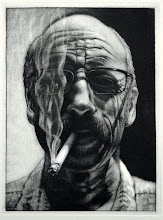When you think about creating a drawing that has a wide range of value, you have to consider that he white of our drawing paper is the brightest white that we have at our disposal for describing the highest level of illumination in a drawing. It's important to identify those areas of our drawing that will remain white. Once these are identified, we can proceed to push everything else back to an appropriate level of "nonwhiteness". If you squint your eyes at the subject, the lightest lights and the darkest darks should become evident.
Rarely do shadows appear as solid black, they usually reflect some light, and they usually have a subtle gradation that changes throughout the shadow area, be on the lookout for that.It is usually slightly darker near the edges of the shadow where it comes into direct contact with the lighter areas (remember simultaneous contrast) and lighter toward the center of the shadow.
We really can't duplicate the intensity of a brightly lit still life by relying on the white of our paper, but we can come close to the dramatic effect of that by exaggerating the darks. Pushing the values down a step or two on the value scale will allow the highlights in your drawing to appear to glow with the same intensity and clarity as your perceptual experience.
We'll get a bit more complicated and challenging this evening and see how our drawing experiences are helping us to see better. Please refer to the post of September 22, 2009 for additional stuff about value.
See you tonight.

No comments:
Post a Comment